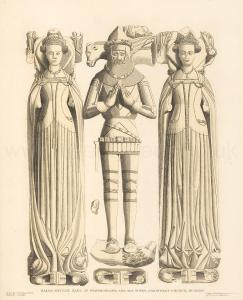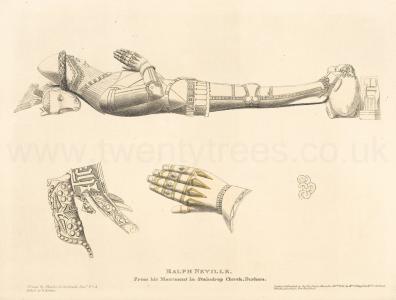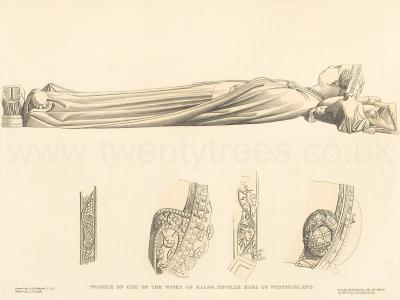Effigy of Ralph Neville, Earl of Westmoreland and his Wives
Effigy of Ralph Neville, Earl of Westmoreland and his Wives is in Monumental Effigies of Great Britain.
RALPH NEVILL was born in 1365, and was the son of the warlike John Lord Nevill, of that "noble, ancient, and spreading family," as it is termed by Dugdale, who derived their descent from Gilbert de Nevill, a Norman who came into England with William the Conqueror. Isabella de Nevill, the descendant of Gilbert in the fourth degree, carried his estate in marriage to Robert Fitz-Maldred, Lord of Raby, in the county of Durham. Their son Geoffrey, in consideration of his mothers great inheritance, assumed the surname of Nevill, and became the founder of the branch of Nevill of Raby, afterwards Earls of Westmorland. Ralph Nevill, the subject of the effigy, was the son and heir of John Lord Nevill, by his wife Maud, daughter of Lord Percy. John de Neville married a second wife, Elizabeth, daughter of Lord Latimer, of Danby, by whom he had John (age 48), afterwards Lord Latimer, who dying without issue the lands of Latimer devolved to Ralph Nevill.
In 1397 Ralph de Nevill was created by King Richard the Second Earl of Westmorland. On the landing of Henry Duke of Lancaster and Earl of Derby, afterwards Henry the Fourth, at Ravenspur, the Earl of Westmorland joined him, with other noblemen, and on the deposition of Richard the Second, and Henry's elevation to the throne, the latter gave him the honour of Richmond for his life, and constituted him Earl Marshal of England. In virtue of this office, he claimed to bear the Lancaster sword (with which the King had been girt as Duke of Lancaster on his entering the district of Holderness) on the King's left side at his coronation. The service was counterclaimed by the Earl of Northumberland, in right of the Isle of Man, but it was adjudged to the Earl of Westmorland.
On the rebellion of the Percys, which was suppressed by the victory of Shrewsbury held, he marched with Sir Robert Waterton against the great power with which the Earl of Northumberland was advancing to aid his son, Henry Hotspur. He kept Northumberland in check, who retired to his castle at Warkworth [Map], where he soon learned the signal defeat which his party had encountered, that -
"Rebellion had bad luck,
And that young Harry Percy's spur was cold."
On the insurrection which followed the same year, headed by the venerable Scroop Archbishop of York, and Thomas Mowbray, in company with prince John of Lancaster, the King's third son, he made head against the rebels, and coming up with them in Gualtree forest, had recourse to a stratagem for their ruin, in which he appears to have sacrificed military honour to state policy.

He entered into a conference with the Archbishop and Northumberland, and gave them to understand, that, if they dismissed their warlike and treasonable array, the grievances of which they complained should be redressed. In consequence of this understanding the rebel army dispersed,
"Like youthful steers unyok'd they take their courses,
East, west, north, south; or like a school broke up,
Each hurries towards his home and sporting place."
Westmorland then arrested the Archbishop, Mowbray, and their associates for treason they were taken to Pontefract [Map], where the King was, and soon after suffered execution. The historical passages to which we have alluded have been dramatized by Shakspeare with a close adherence to the Chronicles, and with a spirit which has embodied the mental character and motives of the principal actors. Among them the Earl of Westmorland is, of course, very conspicuous.

He accompanied Henry the Fifth into France, and was present at the battle of Agincourt.
The Earl of Westmorland lived until the reign of Henry the Sixth (age 8), and was buried at Staindrop [Map], where he had founded and amply endowed a collegiate church. In the chancel of this edifice was erected an altar-tomb, bearing his effigy and those of his two wives, but which has since been removed, with reckless ignorance and barbarous feeling, to an obscure corner in the south-west quarter. His first wife, whose figure reposes on the left hand of that of the Earl himself, was Margaret, eldest daughter of Hugh Earl of Stafford, by Philippa (age 96), daughter of Thomas Beauchamp, Earl of Warwick. Joan de Beaufort (age 51), his second wife, was the only daughter of John of Gaunt, Duke of Lancaster, by his concubine Catherine Swinford, whom he afterwards espoused. Joan was the widow of Robert Ferrers. She died A. D. 1340, and, although she is commemorated by an effigy at Staindrop (the monument most probably being prepared during the life-time of herself and her husband), she was buried in Lincoln cathedral [Map], near her mother, under an altar-tomb, with the following epitaph:





Filia Lancastrise Ducis, inclita sponsa Johanna [Daughter of the Duke of Lancaster, the famous wife Johanna]
Westmorland primi subjacet hic comitis. [Westmorland the first earl is subject here]
Desine, scriba, suas virtutes promere, nulla [Cease, scribe, to earn your virtues, no]
Vox valeat merita vix reboare sua. [A voice worthy of its merits can scarcely be restored]
Stirpe, decore, fide, fama, spe, prece, prole, [Stock, adornment, faith, reputation, hope, prayer, offspring]
Actubus et vita polluit ymmo sua. [He pollutes?? his own life and activity]
Natio tota dolet pro morte, Deus tulit ipsam [The whole nation mourns for death, God has taken it]
In Bricii festo C. quater M. quater X. [On the feast of Bricius, 1425]
The issue of this Earl was very numerous. By his wives he had two-and-twenty children, nine by his first wife, and thirteen by his second.
His children by Margaret were John, who died during his fathers life-time, but whose son Ralph became Earl of Westmorland; Ralph married Mary, a daughter of Sir Robert Ferrers, of Ousley in Warwickshire; Maud, wife of Peter Lord Mauley; Alice, whose first husband was Sir Thomas Grey, her second Sir Gilbert Lancaster; Philippa, married to Thomas Lord Dacres, from whom came the Dacres of the North and South; Margaret to Lord Scroop of Bolton; Ann, to Sir Gilbert de Umfraville, of Lincolnshire; Margery, Abbess of Barking; Elizabeth, a nun of St. Clare, at the Minories, London. By Joan de Beaufort he had Richard Nevill, Earl of Salisbury, father of Richard Earl of Warwick and Salisbury, the Kingmaker; William Lord Fauconberg, created Earl of Kent by Edward IV.; George Lord Latimer; Edward Lord Abergavenny; Robert Bishop of Durham; Cuthbert and Henry Nevill, died young; Thomas Nevill, married the daughter and heir of Seymour; Catherine, wife of John Lord Mowbray, second Duke of Norfolk, and afterwards of Sir John Widvile, son of Earl Rivers; Eleanor, married first to Richard Lord Spencer, next Henry Percy, Earl of Northumberland; Ann, to Humphrey Stadord, Duke of Buckingham, then to Sir Walter Blount, Lord Mountjoy; Jane took the veil; Cicely was wife of Richard Plantagenet, Duke of York, the father of King Edward the Fourth.












The monument of the Earl of Westmorland and his wives is entirely of alabaster. The sides of the altar-tomb are richly adorned with architectural decorations, corbels, pinnacles, and niches, surmounted by elegant little minarets with pointed roofs. At the feet of each of the figures are two chantry priests, with open missals, celebrating divine offices; these are in a sadly mutilated state, the heads being broken oil. See Plate 1. All the figures have the collar of SS. Under the Earl's head is a helmet bearing the crest of the family, a bull's head, and on his surcoat is a saltire; Gules, a saltire Argent, being their coat. Two dogs, wearing collars studded with bells, are at the feet of the Countesses; these animals, so frequently found with figures on tombs, especially those representing females, are the appendages of high rank; they were indeed the ladies' pet dogs. Thus Chaucer:
"Of smale houndes hadde she, that she fedde
With rosted flesh and milk, and waste! brede;
But sore wept she if one of hem were dead,
Or if men smote with a yerde smert-"
Details. Plate H. Profile of the Earl. 1. Richly ornamented wreath on the basinet, with rim of the basinet, the front of which is inscribed i.h.s. 2. Jewelled gauntlet. It will be observed, that the nails of the fingers are represented on those of the gauntlet. 3. Specimen of the mails of the camail. The mailing of the camail was left blank in Mr. Stothard's original drawing, which has therefore been followed, but there is no doubt but he intended it should be filled up. See Plate 1. Plate 111. ProHle of Margaret the Countess. Details. l.Rich circlet and jewelled network confining the hair. 2. Band crossing the breast, and fastening the mantle to the shoulders. 3. Coiffure of Countess Joan. 4. Band or frontlet on her forehead.


